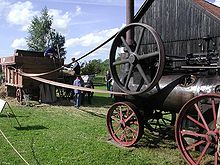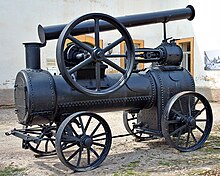Traction engines



A locomobile ( sing. / Fem. , Cf. Locomotive , from Latin locus : place and mobilis : movable), also known as a portable or now sometimes as a locomobile ( neutr. ), Is a closed-type steam engine system that allows everyone to operate The assemblies required for the system ( furnace , steam boiler , control system and the entire drive unit, consisting of cylinder (s), piston, crankshaft and flywheel with belt pulley) are mounted on a common platform.
Locomobiles could be installed in a mobile and stationary manner. In contrast to the automobile , locomobiles were not “auto-mobile” in their basic form, i.e. self-driving - the term “mobile” only means that the system has wheels and can therefore be moved at least passively. This meant that they were pulled to the respective deployment sites by horses or oxen.
Later, however, there were also a number of different self-propelled locomobiles, such as steam road rollers , steam plows , steam tractors and smaller steam boats.
Locomobiles were used all over the world, primarily in agriculture and in large civil engineering projects . Used stationary in mining , they generated compressed air for the rotary hammers and electricity for mine lighting. The side flywheels drove hoisting ropes or sucker rods with which the pits were swamped .
history
In the beginning industrialization, agricultural businesses (to drive the threshing machine ) and small businesses were mechanized with locomotives . In the course of electrification, small power plants were also operated with locomobiles (see e.g. Forach power plant ). In contrast to large systems with a separate design, i.e. with a separate boiler house and separately installed machines, the compact locomotives could be transported relatively easily.
After a few different attempts to find the best possible design, most of the machines were finally manufactured with a drive installed above the horizontal boiler. This design was also the breakthrough for the self-propelled locomobile, as the reinforced boiler made a separate platform unnecessary and all of the machine's components could be accommodated on it.
Even in the beginning of industrialization from 1850, when the power from the water wheels was often no longer sufficient for the new machines, locomotives were hired out by power lenders. They transmitted the power via flat belts to the existing transmission in the factory halls.
Locomobiles were also used in agriculture from around 1810 to the 1970s, and individual systems are still in operation on remote farms to this day.
Outstanding traction engines
In 1910 the Lanz company built their 25,000. Locomobile with the then sensational power of 1000 HP net. It was the largest traction engine in the world until then, was built on the occasion of the World Exhibition in Brussels , used to drive a generator during the 6 months (during the day) for the necessary electricity and received three Grand Prix gold medals for this performance. An 800 hp traction engine from the Buckau R. Wolf machine works worked at night .
Technical specifications:
- Name: Lanz'sche 1000-horse superheated steam valve locomobile directly coupled with dynamo machine
- Mode of operation: Superheated steam compound locomotive ( compound locomotive ) with valve control, Lentz system
- Continuous output: 1000 HP, maximum output over 1 hour: 1150 HP
- High pressure cylinder diameter: 560 mm
- Low pressure cylinder diameter: 970 mm
- Piston stroke both cylinders: 550 mm
- Nominal speed: 215 / min
- Heating tube boiler with two fire boxes and one pull-out tubular boiler each, an additional non-extractable tubular boiler
- Grate area: 3.7 m², boiler pipe area in contact with water: 214 m²
- Superheater area: 73 m² over flat tubes
- avg. Superheated steam temperature: 350 degrees Celsius
- built-in condensation to minimize water consumption
- Average coal consumption: 0.5 kg per hp and hour
The locomobile powered an AEG generator .
- Weight of the anchor: 7500 kg (mounted directly on the crankshaft of the locomobile)
- Voltage: 230 V, switching to 460 V possible
- Power: 735 kW at 215 rpm
- Auxiliary poles for power control from 0 to 100% power

At the Moorseer Mühle Museum in Nordenham -Moorsee, a Lanz locomobile from 1911 can be seen in operation every year on “Steam Day” and at the “Mühlenfest”. It weighs a good five and a half tons and develops 26 hp. This restored "colonial version" was re-imported from Guatemala in 1989 , where it had operated a sawmill. The master miller at the Moorseer Mühle used a similar locomobile to grind grain. In 1908 it was replaced by a stationary steam engine.
Another important locomobile manufacturer was Ottomeyer , which was founded in 1866 in Wellentrup, East Westphalia . Her specialty was the construction of plow locomotives based on other manufacturers ( Fowler , Henschel , Heucke , Rheinmetall , ASTO , Kemna ), which through structural improvements became the most powerful locomotives of all time.
See also
literature
- David Lockett, Norman Lockett: Steam Tractors. Ed. Dörfler im Nebel-Verlag, Eggolsheim 2002, ISBN 3-89555-083-3 .
Web links
- Saxon Steam Engine Association to Wilsdruff e. V. - Information about the Wilsdruffer steam engines & locomobiles
- Locomobile at dampfkultur.de
- Lokomobile ( Memento from March 4, 2016 in the Internet Archive ) on Dampfpflug.de
- Fascinating agricultural technology from yesteryear: plowing with steam , Bayerischer Rundfunk - Unser Land from September 14, 2018
- Video: Commissioning of a mobile threshing locomobile (built in 1911) . Institute for Scientific Film (IWF) 1973, made available by the Technical Information Library (TIB), doi : 10.3203 / IWF / E-1856 .


